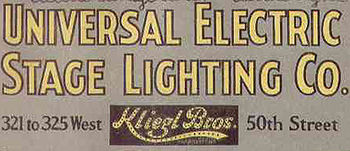
Klieg light
Encyclopedia

Carbon
Carbon is the chemical element with symbol C and atomic number 6. As a member of group 14 on the periodic table, it is nonmetallic and tetravalent—making four electrons available to form covalent chemical bonds...
arc lamp
Arc lamp
"Arc lamp" or "arc light" is the general term for a class of lamps that produce light by an electric arc . The lamp consists of two electrodes, first made from carbon but typically made today of tungsten, which are separated by a gas...
especially used in filmmaking
Filmmaking
Filmmaking is the process of making a film, from an initial story, idea, or commission, through scriptwriting, casting, shooting, directing, editing, and screening the finished product before an audience that may result in a theatrical release or television program...
. It is named after inventor John H. Kliegl and his brother Anton Tiberius Kliegl. Modern Klieg lights use a tungsten
Tungsten
Tungsten , also known as wolfram , is a chemical element with the chemical symbol W and atomic number 74.A hard, rare metal under standard conditions when uncombined, tungsten is found naturally on Earth only in chemical compounds. It was identified as a new element in 1781, and first isolated as...
-halogen
Halogen
The halogens or halogen elements are a series of nonmetal elements from Group 17 IUPAC Style of the periodic table, comprising fluorine , chlorine , bromine , iodine , and astatine...
filament. They usually have a fresnel lens
Fresnel lens
A Fresnel lens is a type of lens originally developed by French physicist Augustin-Jean Fresnel for lighthouses.The design allows the construction of lenses of large aperture and short focal length without the mass and volume of material that would be required by a lens of conventional design...
with a spherical reflector or an ellipsoidal reflector with a lens train containing two Plano Convex lens or a single step lens.
Film
The carbon-arc source was so bright that it allowed film directors to make "day" at night, which also heralded the era of blinding actors – a term coined as "Klieg eyeActinic conjunctivitis
Actinic conjunctivitis is an inflammation of the eye contracted from prolonged exposure to actinic rays. Symptoms are redness and swelling of the eyes. Most often the condition is caused by prolonged exposure to Klieg lights, therapeutic lamps, or acetylene torches...
".
Stage
In the early days of spotlights, the name "Klieg light" became synonymous with any ellipsoidal reflector spotlight, another carbon-arc source or any bright source. Initially developed for film, the Klieg light was adapted to an incandescent stage fixture in 1911.Although not completely certain, the title of the first ERS (Ellipsoidal Reflector Spotlight), often goes to the 1933 Klieglight, which was first used to light an outdoor pageant in New York. Century Lighting introduced their Lekolite
Lekolite
A Lekolite is a brand of ellipsoidal reflector spotlight used in stage lighting. Introduced in 1933 , it was developed by Century lighting which eventually became a part of the Strand Lighting Corporation...
developed by Levy & Kook, hence the "Leko", in the same year.
The Universal Electric Stage Lighting Company, Kliegl Bros. Props. was founded in 1896 and grew to be the largest stage lighting company in the world. The company closed in the 1990s.
See also
- Actinic conjunctivitisActinic conjunctivitisActinic conjunctivitis is an inflammation of the eye contracted from prolonged exposure to actinic rays. Symptoms are redness and swelling of the eyes. Most often the condition is caused by prolonged exposure to Klieg lights, therapeutic lamps, or acetylene torches...
– inflammation of the eye condition that may be caused by overexposure to these lights - LimelightLimelightLimelight is a type of stage lighting once used in theatres and music halls. An intense illumination is created when an oxyhydrogen flame is directed at a cylinder of quicklime , which can be heated to 2572 °C before melting. The light is produced by a combination of incandescence and...

